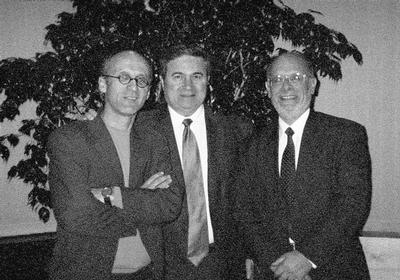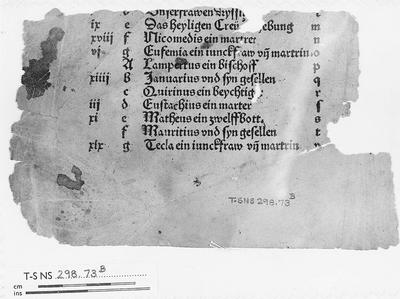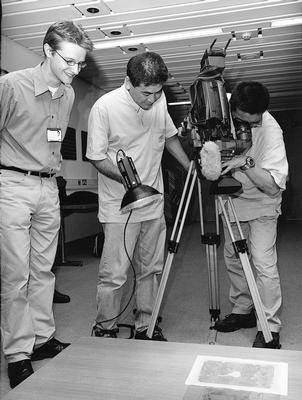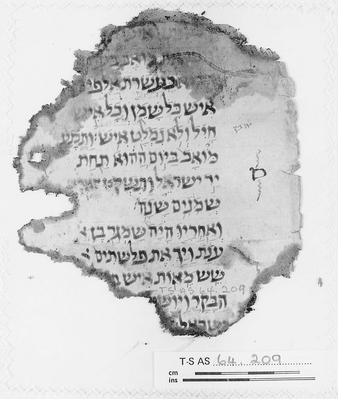![[UL Logo]](../../gifs/ullogo225w.jpeg)
![[UL Logo]](../../gifs/ullogo225w.jpeg)
On other pages
Record sum for Research UnitIn the past twelve months, a record annual sum of almost £190,000 has been raised from external sources for the work of the T-S Unit. The task now is to locate sufficient funding to ensure the continuation, throughout the academical year 2003-4, of all the Unit's current research projects. A generous promise of substantial funding has been made by the Friedberg Genizah Project at the University of Waterloo in Ontario, and there are welcome indications from other major donors that they, too,will be assisting us. In the course of the summer, the Unit again benefited from helpful contributions made by a number of its friends. It is especially grateful to Mrs Sophie Cohen (£1,000), the Sydney and Elizabeth Corob Charitable Trust (£500), the Goldberg Family Charitable Trust (£400), and Dr George Remington, who kindly arranged an anonymous donation (£350). Among others who provided important assistance are the Ruth and Jack Lunzer Charitable Trust (£250); the Sternberg Charitable Foundation (£250); the Harbour Charitable Trust (£200); and Mr Anton Felton (£200). Other groups and individuals to whom the Unit is indebted are Mr Elliot Philipp (£150); Daphna Wizo (£150); Spiro Ark (£120); the Outlook Group (£120); Northwood and Pinner Liberal Synagogue (£100); the Rofeh Trust (£100); Mrs Miriam Shenkin (£100); and the Yakar Educational Foundation (£100). The Cambridge in America office in New York received a number of donations earmarked for the Unit, including gifts from Professor Benjamin and Mrs Barbara Friedman ($500), Mrs Cynthia J. Weber ($180), Ms Evelyn Berezin ($100, in memory of Mr Israel Wilenitz), and Dr W. Randall Carr ($100). A number of other smaller or anonymous donations from supporters across the world have been received and are also much appreciated. 
Professor Stefan Reif (right) with Professor James Diamond, of the Friedberg Genizah Project, and Professor Paul Socken at the University of Waterloo, near Toronto, Ontario, Canada Friedberg boostThe Friedberg Genizah Project at the University of Waterloo has indicated that it will make additional funding available for the expansion of the Unit's projects to describe Cambridge's Hebrew and Arabic fragments, if suitable specialists can be found. Potential researchers may be either post-doctoral students with specialized knowledge of medieval Hebrew and/or Arabic and experience of manuscript research or established scholars who would welcome an opportunity of working on the Genizah texts while spending a sabbatical period at Cambridge. Those wishing to be considered for such posts should write to the Director of the Unit, Professor Stefan Reif, with details of their qualifications and experience and an indication of which areas of Genizah research are of special interest to them. From the Editor's deskThirty years of T-S achievement Last month marked the thirtieth anniversary of my arrival in Cambridge to take over responsibility for the Taylor-Schechter Genizah Collection. Next February, the Genizah Research Unit will itself complete its thirtieth year and now is perhaps an appropriate time to take stock of what has been achieved during these three decades. In 1973, there were no catalogues of the Collection; no research project existed; there was neither staff nor funding; and most of the fragments had yet to be conserved. Some scholars around the world felt that the University of Cambridge had failed to meet its responsibilities with regard to the Collection, in the areas of both specialized research and broader education. They wrote with their criticisms and suggestions. Those familiar with medieval manuscript research will appreciate that the task of rectifying this situation made considerable scholarly and intellectual demands on those involved in the Unit's work. It is notoriously difficult to identify, describe and analyse Genizah fragments and to find specialists who have the ability to plan and execute related research projects and publications. Ranging as they do over the whole field of medieval Hebrew and Jewish studies, the Cambridge Genizah manuscripts demand a high degree of competence in such disparate areas as Bible, Rabbinics, Semitics, Jewish law, and Hebrew liturgy, as well as advanced personal research experience in at least some of these subjects. Researchers in the Unit could hardly look elsewhere for guidance, since none of the Genizah collections around the world had been adequately described, conserved or made available. Over the years, the sorting, conservation and microfilming of all 140,000 fragments have been completed. The contents of 32 crates of neglected material have been classified into the Additional Series, and almost two-thirds of the Collection has benefited from scholarly description. Fifteen volumes have appeared in the "Genizah Series", published by Cambridge University Press for Cambridge University Library, and fifteen visiting scholars of world repute have worked here on various parts of the Collection. The first bibliographical volume in the Series has become an essential reference text for all those engaged in Genizah research, and a second volume is in the press. Thirteen young researchers have been trained in the Unit and have gone on to important posts in oriental faculties and libraries in Britain, France and Israel, three as full professors. Over $2.5m has been raised from external sources for Genizah research at Cambridge, and the results have been brought to the wider public through more popular publications, media involvement, and important international exhibitions. The progress made at Cambridge has been a major factor in the noteworthy expansion of Genizah research, publication and management at a number of leading institutions around the world. A lively and extensive website has been established, with substantial data about the Genizah material and digital images and descriptions of hundreds of fragments. It has been included in the British Academy's selective Portal directory. The Unit's newsletter, Genizah Fragments, which made its first appearance in April 1981 and has, since its launch, been professionally designed and subedited, now reaches about 2,000 readers. For those who have contributed to these achievements, all this is most gratifying, particularly since personal research and publication have also been successfully completed while the needs of the Collection have been served. The hope is that it will not require anything like another thirty years to see the last of the fragments satisfactorily described. Stefan C. Reif 
T-S NS 298.73: part of a sixteenth-century calendar, printed in Strassburg, with a list of Christian saints and martyrs How 'M' solved calendar mysteryAn intriguing phenomenon is the existence of non-Jewish fragments among the material from the Cairo Genizah. One such example at Cambridge University Library bears the classmark T-S NS 298.73. The fragment consists of the lower halves of two paper pages printed in German. The surviving text contains a list of Christian saints and martyrs and mentions such zodiacal signs as Scorpio and Libra, as well as practical advice on eating habits. The fragment was identified through a detailed comparison of the letter "M" as it appears there with catalogues of typefaces used by German book printers in the fifteenth and sixteenth centuries. It emerged that the pages belonged to the Teutsch Kalender published in Strassburg in 1504 by Matthias Hupfuff. This popular and anonymous handbook was produced several times by different printers in South Germany between 1481 and 1522. It consists of a perpetual calendar and medical advice on such topics as bloodletting and bathing, with significant astrological content. The fifty folios are illustrated with fine black-and-white woodcuts. How did this book, or at least these two pages, find their way into the Cairo Genizah? Or, more fundamentally, did they belong to that collection at all? Given the lack of archaeological standards during Solomon Schechter's discovery of the Genizah fragments, there is no certainty about the answer to this latter question. But it is conceivable that a Jew who did business with Christians would have had to become acquainted with their calendar and holy days. It is true that Jews were expelled from Strassburg as early as 1388 but they were allowed to live in the vicinity and to attend the market. The Ashkenazi community in Jerusalem was increased by the arrival of German Jews in the first half of the sixteenth century. The well-known Yiddish letters written in Jerusalem in 1567 by Rachel Zussman to her son Moshe in Cairo supply evidence of at least one Jew in Egypt who understood German. One cannot therefore rule out the possibility that this T-S fragment came to Cambridge from the Cairo Genizah. In any event, it represents a rare copy of the Teutsch Kalender and confirms once again the wealth of the Jewish archive from Old Cairo. A fuller description of the fragment appeared in the EAJS Newsletter, 12 (2002), pages 24-27. Bill Rebiger As this issue went to press, an additional fragment of the Teutsch Kalender came to light. While working on the description of the Additional Series, Dr Friedrich Niessen discovered a page, of which five lines have survived, with a list of bishops. Its classmark is T-S AS 192.365 and it measures 5.5 x 7 cms. Rich insight into world of KaraitesA split in Judaism that took place, according to the common view, around the eighth or ninth century CE, and according to the members of the movement almost a thousand years earlier, gave rise to the emergence of Karaism. In brief, the Karaites totally reject rabbinical interpretation of the law, as included in the Mishnah, Talmud and the halakhah, and adhere to the Hebrew Bible, regarding it as the divine and everlasting canon of Jewish law. Polemics between the Rabbanite and Karaite leaders reached a climax in the Middle Ages, when the rabbis of the time - among them Sa`adya and Maimonides - repeatedly warned their followers against the Karaite movement, which flourished for about three centuries, with followers in both East and West. The Karaites bequeathed a rich written corpus, including an independent prayer-book, an alternative biblical exegesis, and a grammatical tradition often at variance with the norms set by the well-known medieval linguists of the Rabbanites. Many of their works reached us only through what survived in the Cairo Genizah. Exegesis and Grammar in Medieval Karaite Texts, edited by Geoffrey Khan, is published by Oxford University Press as Supplement No.13 of the Journal of Semitic Studies. Its eight articles, seven of them by students of the editor, are mainly revised versions of papers read at the conference of the British Association of Jewish Studies held at the University of Leeds in the summer of 2000. Three articles analyse Yefet ben Eli's commentary on the Minor Prophets, on a verse from Psalms, and on the identity of the "redeemer" in the Book of Ruth. All three writers emphasize the originality of the commentator, though his methods often echo rabbinical traditions. Two further articles are devoted to the works of Abu al-Faraj Harun ibn al-Faraj, a prolific Karaite grammarian and lexicographer who lived in Jerusalem in the eleventh century; while a third, by T-S Unit researcher Ben Outhwaite, deals with the style of the letters of Toviyyah ben Moshe, an eleventh-century leader of the Byzantine Karaite community, and an author and translator of Arabic works into Hebrew. Geoffrey Khan's own excellent contribution (which should ideally have been the opening essay in the book) provides a general introduction to the Karaites' work and examines the biblical exegesis and grammatical theory of the Karaite tradition. Outlining "the ways in which grammar was used as a basis of biblical interpretation in the Karaite tradition of Hebrew grammatical thought", Khan concludes that early works by Karaite grammarians set out to prove, as did the works of the Masoretes, that grammatical variations reflected semantic differences. Abu al-Faraj Harun, on the other hand, a representative of the classical period, was less concerned about such grammatical differences and instead employed contextual analysis based on general principles of language. An anonymous Karaite commentary on the Book of Hosea, consisting of scores of small pieces discovered and pieced together by Friedrich Niessen (a Research Associate in the T-S Unit), draws attention not only to an unknown Karaite commentary, but also to the Cairo Genizah's continuing role as an inexhaustible source of literary treasures. The book is a valuable contribution to the field of Karaite studies. Detailed indexes of subjects, terminology and authors discussed would, however, have been helpful additions. Avihai Shivtiel The Genizah Research Unit is most grateful to the family of the late David Lauffer, who was among its early supporters, for generously defraying the cost of producing this issue of Genizah Fragments. David was keenly interested in Jewish history in general and in the contribution made to its study by the manuscripts from the Cairo Genizah in particular. 
The T-S Unit's Dr Ben Outhwaite (left) with NHK cameramen Spotlight on UnitIn the course of almost a year, 457 visitors - usually in organized groups - have come to see some of the Cambridge Genizah treasures and to hear researchers in the Unit talking about their work and discoveries. Among recent distinguished guests welcomed by Unit staff was the Israeli novelist Aharon Appelfeld. He and his wife were participating in "The World of Aharon Appelfeld" conference arranged by Dr Risa Domb, Director of the Centre for Modern Hebrew Studies in the Faculty of Oriental Studies at the University of Cambridge. Dr Avrum Ehrlich and Ms Sheree Coleman, who are preparing an educational television programme, entitled "The Abraham Chronicles", for Sonart Meca Pty Ltd in Australia - possibly to be broadcast on the History or Discovery channel - filmed Genizah material and interviewed the Director of the Unit, Professor Stefan Reif, about the importance of its contents. Two Japanese film crews, from NHK in Tokyo and the National Museum of Ethnology in Osaka, included Genizah material in documentaries they were preparing, featuring Professor Geoffrey Khan, formerly of the Unit, and now Professor of Semitic Philology in the University of Cambridge. One film is on the history of economics and the other is to accompany an exhibition on the Tales of the Arabian Nights, in the Osaka Museum. Groups also visited from the Association of Jews from Egypt, Daphna Wizo, Jewish Studies Summer School at the Faculty of Divinity, the Leeds branch of the Jewish Historical Society of England, Northwood and Pinner Liberal Synagogue, Outlook Group, Spiro Ark Institute at Middlesex University, Society for Biblical Literature annual conference, Tikvah (Emunah) Society, United Mizrahi Bank, and Yakar Educational Foundation. A total of 388 responses were also made to enquiries and requests, including 106 by e-mail. Volume welcomedRecent weeks have seen the publication of the first two reviews of the volume of essays that appeared last year in the "Genizah Series" published by Cambridge University Press for Cambridge University Library. Entitled The Cambridge Genizah Collections: Their Contents and Significance, and edited by the Unit's director, Stefan Reif, with the assistance of his wife, Shulie, it has 229 pages, with twenty-two plates and full indexes, and retails for £45 (ISBN 0 521 81361 1). In her piece for the Review of Biblical Literature (RBL) - available electronically through the Society of Biblical Literature (www.sbl-site.org) - Tamar Zewi, of the University of Haifa, wrote: "All the authors of the papers are leading scholars in the field they discuss. All the papers are richly annotated with important references. The book is accompanied by excellent indexes and a very good choice of plates, representing major topics and examples discussed in the papers. All these features make the book a highly valuable tool for anyone involved or interested in Genizah research." The Reverend Dr Anthony Gelston, Reader Emeritus in Theology at the University of Durham, wrote a notice for Book List 2003 of the Society for Old Testament Studies, published as the Journal for the Study of the Old Testament 27.5 (2003). Dr Gelston commented: "The nine lectures [originally given at Cambridge University Library] are presented here in updated form, and prefaced by a magisterial introductory survey by the editor... "A comprehensive list of biblical references will enable scholars to see at a glance whether there is any material relevant to a particular passage. "This is an excellent book, and a worthy tribute to the importance of the Genizah Collections and of the work done in the Genizah Research Unit at Cambridge University Library." An Arabist's viewIn an Arabic article entitled "The Genizah Documents and their Importance for the Study of the Economic History of the Ports of the Hijaz and the Yemen in the Middle Ages", published in Al-Yaman Magazine, Number 15 (May, 2002), Hasanein Muhammad Rabie analyses at length the importance of the Cairo Genizah for the study of medieval trade routes along the Mediterranean, the Red Sea and the Indian Ocean. He emphasizes the vital role of the Genizah in the study of various aspects of medieval society, particularly given the scarcity of information provided by medieval Arab historians. Rabie concludes his article by stressing the great need to refer research students in Arab countries to this sound and inexhaustible historical source. Poetic portraitsYehuda ha-Levi and his Circle: 55 Geniza Documents, by Ezra Fleischer and Moshe Gil (World Union of Jewish Studies, Jerusalem, 2001), is a welcome critical edition of the personal archive of the Cairene businessman Abu Sa`id Halfon b. Nethanel ha-Levi al-Dimyati. This archive consists of items dating between 1129 and 1142, forty-five of which are from the Taylor-Schechter Collection at Cambridge University Library. The introductory chapters provide a detailed picture of Halfon's life and of those connected to him, particularly the poets Yehuda ha-Levi and Isaac Ibn Ezra. Each of the documents, presented in chronological order, is preceded by a short description of its contents and is followed by a transcription of the manuscript in Judaeo-Arabic and a translation into Hebrew, with critical notes. Photographic plates supply images of the original manuscripts. Halfon's archive opens yet another door to the Genizah world - to certain well-known personalities in particular and to medieval Mediterranean life in general. As most of the letters are either from or to Halfon, much is learnt about the man himself. He emerges as a fascinating character - a successful businessman, highly respected, well-travelled, a lover of books and a connoisseur of fine poetry, deeply devoted to family while remaining, unusually for his day, unmarried. The correspondence between Halfon and Yehuda ha-Levi offers insights into the latter's inner life, including his reasons for writing his chef d'oeuvre, the Kuzari, and his thoughts on travelling to the Holy Land. Other documents help complete his biography. T-S AS 146.4 confirms that ha-Levi took a ship to the Land of Israel, and some faded writing around the margin of T-S 13J9.6, written anonymously about three months after his death, suggests that he did, in fact, reach Jerusalem. Fleischer and Gil entitle their study Yehuda ha-Levi and his Circle precisely because the archive comprises a great many documents that pertain to the life of the poet, as well as, most importantly, five letters written in his own hand. These include a previously unpublished document (ENA NS 18, f.33), the only surviving letter written by him while in Egypt, in which he describes the great welcome accorded to him in Alexandria. Contrary to suggestions that he might have enjoyed his stay too much, he expresses regret that he had no time to spend alone, living in abstinence, as befitting an old man in what he thought would be the last days of his life. The book builds on research initiated by S. D. Goitein and Jefim (Hayyim) Schirmann and incorporates the work of later scholars. These include Joseph Yahalom, whose most recent article chronicles the last years of ha-Levi's life ("Judah Halevi: Records of a Visitor from Spain" in The Cambridge Genizah Collections: Their Contents and Significance, edited by S. C. Reif, Cambridge University Press, 2002). The present volume offers all the documentary material available to date, including two hitherto unpublished letters (T-S 8J15.16 and ENA NS 7, f.1) by Isaac Ibn Ezra to Halfon. The work is an invaluable research tool and will doubtless inspire many current and future Genizah scholars. Rebecca J. W.
Jefferson 
T-S AS 64.209 recto: Judges 3:28-31, with decorated samekh and non-standard Tiberian vocalization Biblical insightsAn enormous number of Bible fragments from the Middle Ages has been discovered in the Cairo Genizah. They range from large sections of leather Torah scrolls, through vellum leaves from beautifully written and carefully annotated codices, to scraps of paper bearing a few verses for private reference. Following the successful publication twenty years ago of the first two volumes of Hebrew Bible Manuscripts in the Cambridge Genizah Collections, the important work of describing the Bible fragments in the Genizah is now complete with the publication, by Cambridge University Press for Cambridge University Library's "Genizah Series", of the third and fourth volumes. The two new volumes present a comprehensive catalogue of the Hebrew Bible fragments in the Taylor-Schechter Additional Series, describing in detail an impressive total of 14,679 items. Besides the identification of the exact content of each fragment, the volumes contain thorough physical and linguistic descriptions, as well as notes on additional features of interest. Addenda and corrigenda for the previous volumes are included in volume 4. A canonical index facilitates searching for relevant fragments by biblical book and chapter. Taken together, all four volumes now provide the researcher with details of 24,260 biblical fragments in the Cambridge Genizah Collections and will be an indispensable resource for those with interests in Hebrew Bible, Jewish Studies and Semitics. Details are as follows: Hebrew Bible Manuscripts in the Cambridge Genizah Collections: Volume 3: Taylor-Schechter Additional Series 1-31, described by M. C. Davis and Ben Outhwaite, xiii+500+16 plates, ISBN: 0521816122; Hebrew Bible Manuscripts in the Cambridge Genizah Collections: Volume 4: Taylor-Schechter Additional Series 32-225, described by M. C. Davis and Ben Outhwaite, with addenda to previous volumes, xi+553+16 plates, ISBN: 0521816130. Price: £90 per volume. How you can help the T-S UnitIf you would like to receive Genizah Fragments regularly, to enquire about the Taylor-Schechter Genizah Collection, or to know how you may assist with its preservation and study, please write to: Professor S. C. Reif, Director of the Taylor-Schechter Genizah Research Unit, at Cambridge University Library, West Road, Cambridge, CB3 9DR, England. The Library may also be reached by fax (01223) 333160, or by telephone (01223) 333000. The Internet access is at http://www.lib.cam.ac.uk/Taylor-Schechter. Enquiries by e-mail should be addressed to genizah@lib.cam.ac.uk. All contributions to the Unit, whether for the research programme or for its other activities, are made to the "University of Cambridge", which enjoys charitable status for tax and similar purposes. In the USA, "Cambridge in America" supports the Taylor-Schechter Collection with its unfunded grant number 7/78. If you are interested in supporting this project, please contact the Director of the Annual Appeal at: 309 West 49th Street, New York, NY 10019-7399 (tel: 212-984-0960). "Cambridge in America" is recognized by the IRS as a charitable organization, and contributions are legally deductible for USA income tax purposes. Contributions are similarly deductible in Canada even if made directly to "Cambridge in America" at the University of Cambridge. |
Edited by Stefan C. Reif
If you have any questions, please e-mail
genizah@lib.cam.ac.uk
Return to the Genizah Fragments index
Return to the Taylor-Schechter Home Page
Return to Cambridge University Library's Home
Page